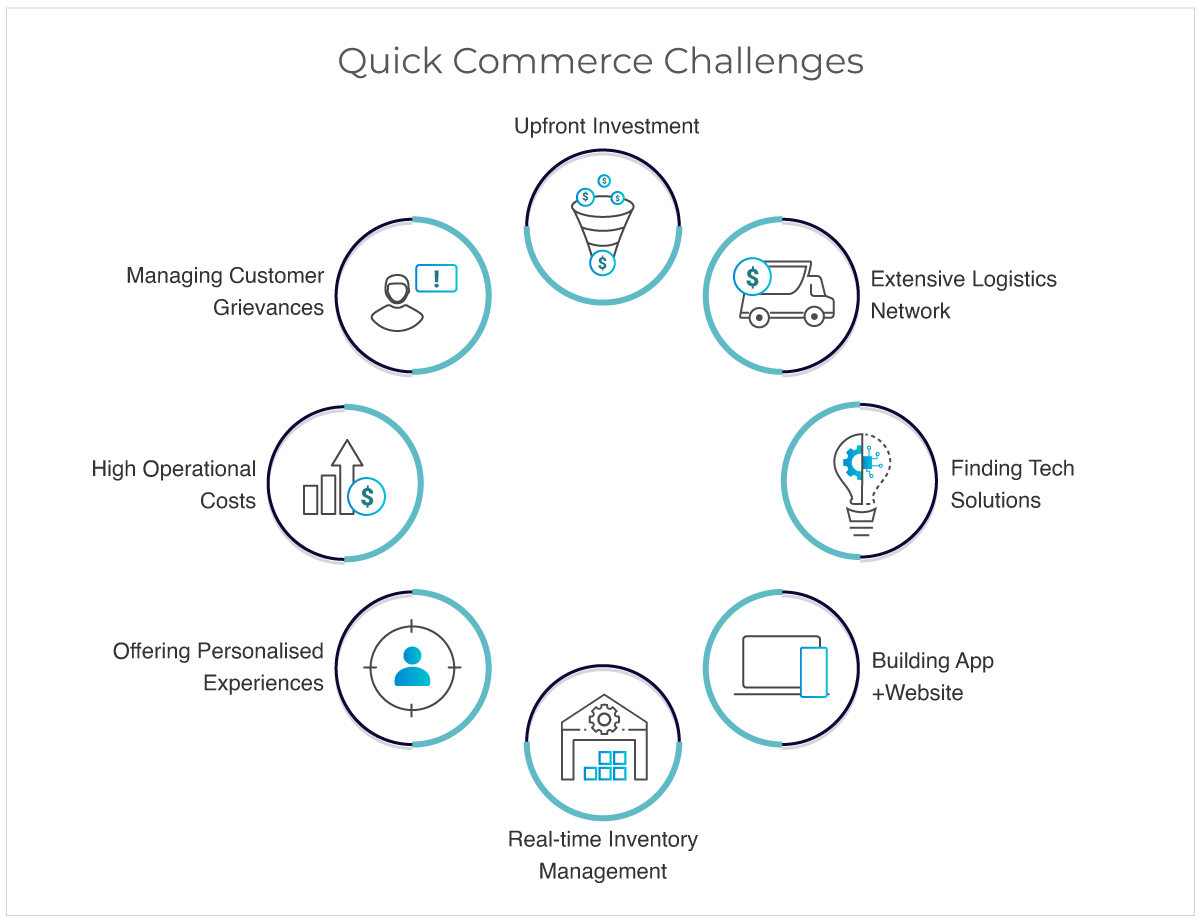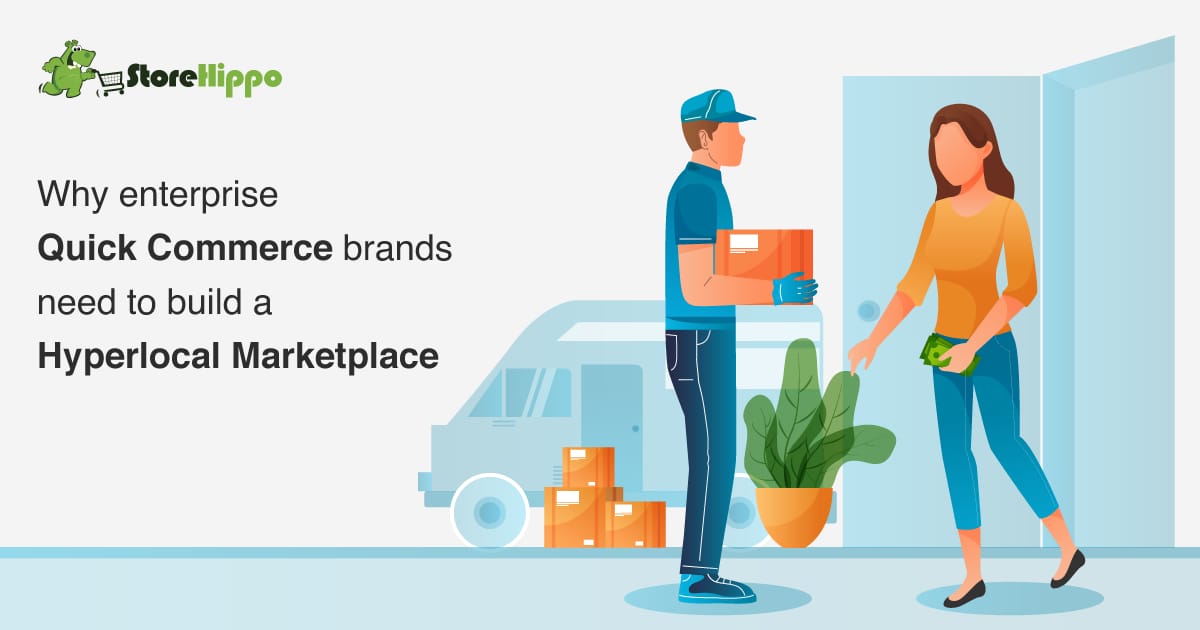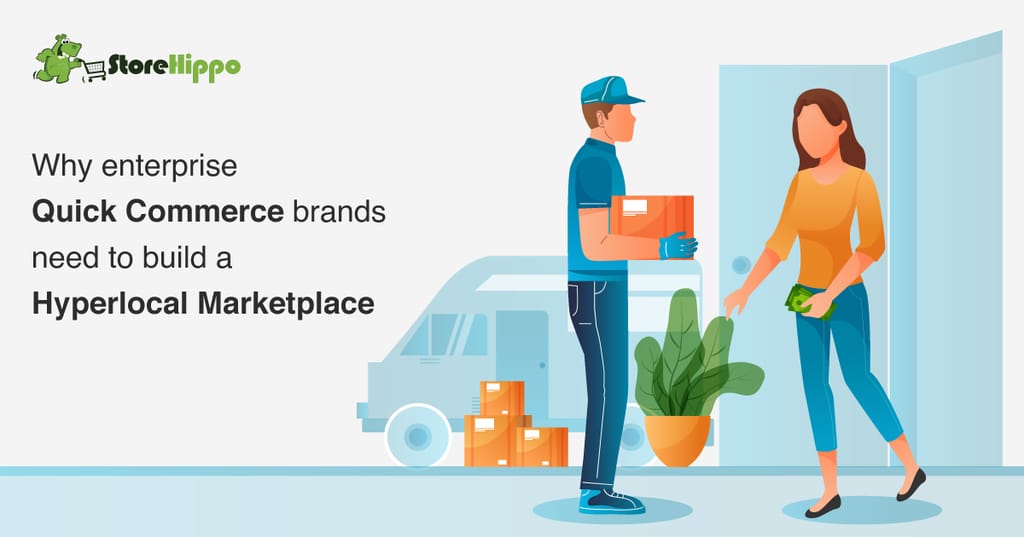The next generation of ecommerce has arrived. It’s fiercer and faster and customers are lapping it up like never before.
Yes, we are talking about Quick Commerce, the hottest ecommerce trend already showing signs of disruption.
And the most amazing development in the past few months is that Q-Commerce is no longer about grocery and everyday essentials. Now, everything from electronics to cosmetics to jewellery is available on popular quick commerce apps.
With its rapid expansion, Quick Commerce is redefining convenience for buyers and empowering businesses to scale and thrive in once unimaginable ways.
Table of Contents
- The Rise of Quick Commerce in India: Changing Ecommerce Forever
- What is Quick Commerce?
- How does Quick Commerce work?
- Challenges Of Starting A Quick Commerce Company
- Quick Commerce Marketplace - The Innovative Solution To Rule Hyperlocal Markets
- How Enterprises can beat the Quick Commerce competition With Hyperlocal Marketplace Model
- How StoreHippo helps in building a vendor based quick commerce brand
- Conclusion
The Rise of Quick Commerce in India: Changing Ecommerce Forever
The evolving QCommerce dynamics are reshaping the ecommerce landscape with unprecedented speed and impact.
Here are a few trends and stats to help you understand how this hybrid business model is disrupting the ecommerce landscape.

Q-Commerce Revenue Growth
- 230% growth from 2021 to 2023
- $3.35 billion forecasted revenue in 2024
- $5.5 billion market value by 2025
- $9.95 billion forecasted revenue by 2029
- 24.33% is the CAGR between 2024-2029
- $45 Billion- Total addressable market size (TAM)
Quick Commerce User Penetration
- 1.8% in 2024
- 4.0% by 2029
- 60.6m users by 2029
Quick Commerce Buying Frequency
- 60%-65%- retention rate of quick commerce buyers
- 30-40 times/month is the order frequency of top q-commerce buyers
Quick Commerce Market Penetration
- 7% market penetration in 2020
- 12.5 market penetration by 2025
Q-Commerce Share In Ecommerce
- 33%-35% of FMCG ecommerce sales come via Q Commerce
- 2X growth of quick commerce to overall ecommerce between 2023-2024
Source: Statista, Tech Crunch, ET Retail, RedSeer
The stats say it all, the quick commerce model has arrived in India with a bang!
Before we move ahead, let’s first understand how qcommerce is different from regular ecommerce.
What is Quick Commerce?
Quick Commerce is a niche ecommerce segment that is centred around quick delivery of everyday essentials.
In simple terms, Q-Commerce = Ecommerce done faster.
Quick commerce means faster ecommerce deliveries (within 10-30 minutes of placing the order). These orders consist mainly of consumable items like groceries, fruits, vegetables, FMCG products, stationeries, personal care products, medicines and sometimes food items like bakery products. Quick commerce in nutshell is all about convenience and started with a focus on improving the user experience in the Kirana/grocery sector.
However, the brands evolved over time and used their infrastructure to capitalise on opportunities offered by local demands. Brands now offer extensive inventories to cater to seasonal demands for non-essential items. For example, many Qcommerce brands offered flowers and gift options on their portal for Valentines Day, Holi-related food delicacies and sweets along with colours and other Holi essentials during Holi etc. Toys, cosmetics and home appliances are the non-essential category driving substantial revenue for popular quick commerce apps.
How does Quick Commerce work?
Typically, the q-commerce brand sets up micro warehouses called dark stores at different locations to service online orders quickly. Alternatively, they can also partner with local vendors or retail stores for non-essential items to fulfill orders in 10-20 minutes.
.png)
A typical quick commerce brand has the following flow for setting up the business and fulfilling orders:
- A qcommerce brand is set up with serviceable areas within a city or across the country
- The brand sets up micro warehouses in different locations to service orders quickly
- Along with local grocery/Kirana/daily essentials inventory in dark stores, quick commerce companies also onboard local non-essential product dealers, for example, local florists or mithai shops during festivals. These vendors have their own set up, warehouses, delivery boys etc. and fulfill orders under the parent qcommerce brand name.
- Orders placed by customers are automatically routed to the nearest dark store or the seller closest to the customers’ location
- Each sub-store/micro warehouse has its fleet of delivery agents who are well aware of a given locality and they deliver orders in the shortest possible time
The complete order cycle of a quick commerce order usually takes less than 60 minutes, i.e, from the time a customer starts searching for products online to finding the qcommerce brand and finally ordering and getting the order delivered is typically done in 20-40 minutes.
Challenges Of Starting A Quick Commerce Company
With a whopping 24.33% CAGR forecast, qcommerce appears to be a rewarding model for enterprises planning to capitalise on the booming hyperlocal commerce sector. However, the enthusiasm to adopt the model is not reflected in the number of quick commerce companies we have in the market.
The reasons are quite apparent. Setting up Quick Commerce operation requires heavy upfront investment and significant effort in organising and streamlining quick deliveries in an efficient way.

Despite the immense growth potential, the following factors have deterred many enterprises from entering the Quick Commerce segment:
- Upfront Investment in setting up warehouses and stocking inventory
- Setting Up Extensive logistics network to coordinate rapid deliveries
- Finding Cutting Edge technology solutions to build website and app for hyperlocal marketplace for fast deliveries
- Building and maintaining a user-friendly quick commerce app and website
- Real-time Inventory Management to ensure streamlined fulfilment and avoid discrepancies
- Offering personalised buying experiences and discounts can be difficult for different buyer segments across diverse hyperlocal markets
- High operational costs for running the complete infrastructure from setup to quick deliveries to managing a streamlined logistics network
- Managing Customer Expectations and grievances requires adapting quickly to buyer demands and market dynamics which can be challenging
It’s evident that quick commerce companies need to do a lot of juggling and upfront investment to stay afloat in the market.
Quick Commerce Marketplace - The Innovative Solution To Rule Hyperlocal Markets
With the COVID-driven conditioning for convenience, online consumers have shown a preference for micro order sizes and faster fulfilment. Impulse purchases by tech-savvy millennials and Gen Z buyers have also accelerated the demand for better supply-side conditions.
Taking the cue from these customer behaviour insights, retail bigwigs like Flipkart Quick, Blinkit, Zepto, Apollo, Swiggy Instamart, and many others have quickly and aggressively pivoted their business model to win in the new-found Q commerce battleground.
Mid-size enterprises that already have a significant local presence are also vying for their own spot in the qcommerce market. However, the micro warehouse-based quick commerce model entails huge resources and time investment which is not feasible for small and mid-level enterprises.
For new entrants the competition is fierce and the journey is uphill.
But there is an alternative to the investment-heavy traditional quick commerce business model which can help enterprises easily enter and rule the market.
It is the Vendor-Powered QCommerce Hyperlocal Marketplace!
How Enterprises can beat the Quick Commerce competition With Hyperlocal Marketplace Model
The hyperlocal model is a smarter alternative for enterprises that have the experience and expertise to grow quickly in the qcommerce domain.
A hyperlocal marketplace model is an improvement over the inventory-based micro warehouse model as it frees the enterprise brand from the burden of stocking up and managing inventory. Also, it brings in local stores as vendors who already have a fairly good and nuanced understanding of the given location, its market size, customer preferences, local seasonal peaks etc.
Here is how the dealer-powered qcommerce marketplace functions.

How Dealer-Based Quick Commerce Marketplace Is a Better Alternative
Here are some other advantages of building a dealer/vendor based hyperlocal marketplace for quick commerce brands:

Get Started Quickly
By doing away with the inventory-based model qcommerce brands no longer need to set up warehouses and stock them up with inventory. They can use a turnkey marketplace solution combined with multi-store set-up and have their Quick commerce brand up and running. The onboarded vendors take care of the inventory and delivery agents. The quick commerce brand can manage all its vendors for different locations, their respective inventories and delivery agents from a common central admin dashboard.
Cost-Efficient
Setting up a hyperlocal marketplace is a cost-effective solution compared to building a qcommerce brand from scratch. With no costs involved in setting up and managing warehouses, the qcommerce brands save a lot on CAPEX and resource hiring costs.
The expenditure thus saved can be used more strategically to grow the business and build data-driven expansion strategies.
Leverage Vendors’ Logistics
Hyperlocal quick deliveries can be easily streamlined in a vendor-powered marketplace where each vendor has their own delivery boys or uses local last mile delivery partners. This fulfilment approach not only enhances delivery efficiency but also reduces overhead costs for the quick commerce company.
By utilizing existing vendor networks’ lopgistics, q-commerce brands can scale operations rapidly while maintaining quick delivery for customer satisfaction.
Scale Up To New Products and Areas
With the hyperlocal marketplace scaling to new product categories or new geo-locations becomes faster. Currently, most of qcommerce activity is concentrated in tier 1 cities. However, there is a growing demand for such services even in tier 2 and 3 cities.
Qcommerce brands built on the hyperlocal marketplace concept can simple onboard new vendor stores from new geolocations and start operating in these areas. Also, expanding to new product lines becomes easier as the quick commerce brand can partner with the most reputed dealers for those product lines and leverage the dealer network across the country to fulfil customers’ orders.
Pivot To New Business Models
The hyperlocal ecommerce market is changing rapidly driven by customer demands. To cater to the changing market demands brands need to think of innovative hybrid business models that can be implemented quickly. It becomes easier for brands already using a cutting edge hyperlocal ecommerce solution to pivot to new business models. They can quickly adapt to the market dynamics by tweaking their flow to build new disruptive hybrid models that take them miles ahead of the competition.
Sell Better With Personalization
Personalization is the success mantra for modern brands whether it is quick commerce or any other business model. Implementing personalization becomes easier in a location-based hyperlocal marketplace. Brands can not only personalize the prices and deals but they can also offer personalized languages, landing pages, payment options, customized delivery solutions and any other personalization that can help them sell better. With an advanced solution provider like StoreHippo implementing multi-level personalizations is a breeze.
Go Phygital
While customers love shopping online, they also want to hop into real stores on certain occasions. With the dealer/vendor based hyperlocal ecommerce set up for your quick commerce brand, you can actually make it happen. While you add new touchpoints like apps, marketplace, social commerce etc. you can also partner with your vendors and use their physical store to offer a phygital experience to your buyers. Certainly, this would be a major differentiating factor over your quick commerce competitors and would help you gain loyal customers while leveraging the omnichannel strategy.
With so many obvious advantages the dealer-vendor-based hyperlocal marketplace is certainly an improvement over the inventory-based Q commerce model. However, such an extensive hyperlocal set up can be run and managed smoothly and efficiently only when it is powered by an advanced solution that takes care of every aspect of the business.
StoreHippo offers an end-to-end hyperlocal ecommerce solution built on the decoupled headless architecture. Powered by MACH architecture for ecommerce, hyperlocal marketplaces built on StoreHippo are inherently scalable and flexible. They can be easily customized to suit the unique needs of a Q Commerce brand.
How StoreHippo helps in building a vendor based quick commerce brand
To get started with a qcommerce business, brands can partner with StoreHippo and get a comprehensive hyperlocal marketplace solution which includes:
- Complete marketplace solution to set up a quick commerce brand powered by the dealer network instead of a cost-intensive inventory model
- End-to-end hyperlocal marketplace solution that covers every aspect of vendor management right from onboarding the local Kirana and grocery stores to payouts, commissions, discounts and shipping management
- A variety of mobile apps to completely run and manage the business on the go using different inbuilt apps like mobile apps for the customers, for the vendors, for admin(s0 and the delivery boys
- Comprehensive order and inventory management solutions with centralized control
- Inbuilt solutions to add new customer touchpoints like mobile apps, online marketplace, mobile store, social commerce etc. and go omnichannel
- Native multi store ecommerce set up to create multiple location-based stores managed by a common central admin
- Multilingual solutions to build quick commerce apps and websites in multiple languages
- Inbuilt delivery boy solution to manage own fleet of delivery agents for each location and vendor/local store
- Seamlessly integrates with a variety of third-party tools and service providers to help you build your unique solution using your preferred ERP, CRM, POS, accounting, marketing, payments and shipping solutions
- 300+ inbuilt tools and 120+ built-in integrations which help brand build their tailor-made solutions
Conclusion
Quick commerce has changed ecommerce and conditioned customers for instant gratification. The next battleground for qcommerce brands would be to engage and retain customers with offers and services that go above and beyond what the customers have already been accustomed to.
That’s where a next-gen hyperlocal marketplace solution powered by an advanced ecommerce platform like storehippo can make a difference. With StoreHippo to power their Q Commerce journey, brands can easily penetrate new markets, offer seamless and personalized omnichannel buyer journeys and quickly adapt to changing market conditions.
Qcommerce brands vying for customer attention and retention need to be quick in planning and implementing strategic marketing and expansion plans. Storehippo with its inbuilt set of features and tools along with a complete solution for B2B, D2C and B2B2C business models makes it easy for brands to design and create the most unique quick commerce brand.
Ready to set foot in the quick commerce battleground? Start on a strong footing with StoreHippo by your side. Explore our features and solutions, book your free demo right away and take a tour of amazing things you can do for your business!





















8 Comments
Leave a Reply
Leave a Reply
Leave a Reply
Leave a Reply
Leave a Reply
Leave a Reply
Leave a Reply
Leave a Reply